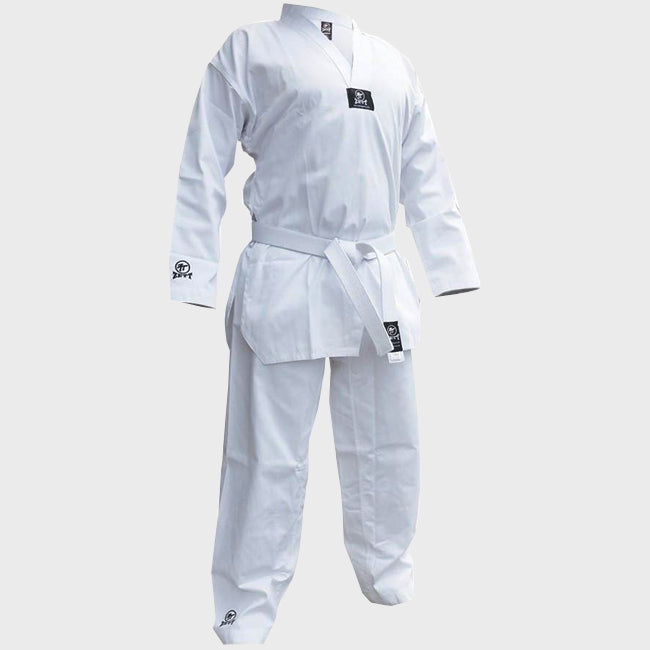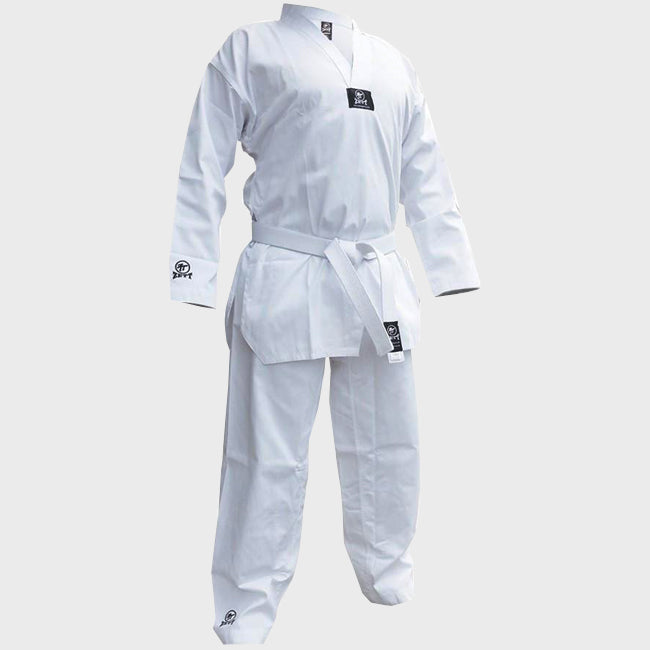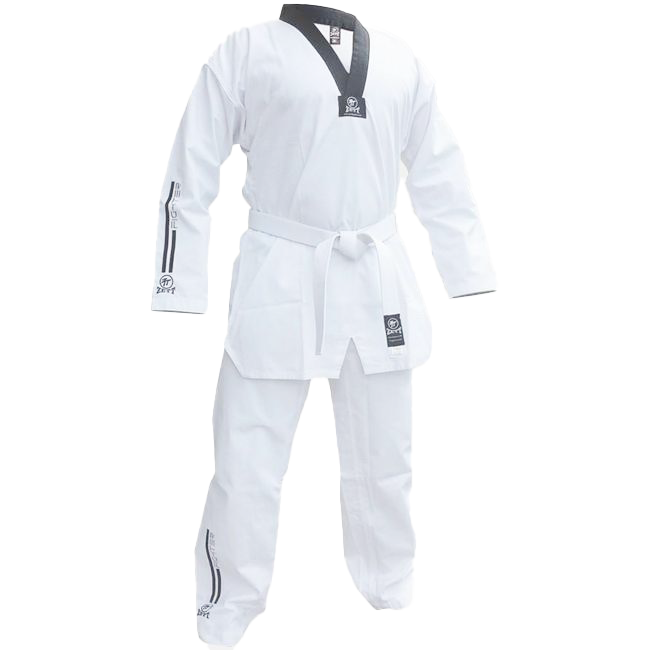Filters
Taekwondo Uniforms to Unleash Your Power
Taekwondo is a rewarding sport that combines the grace of an artform with discipline and explosive physicality. For taekwondo uniforms that deliver flexibility, speed, power and kinesthetic sense, browse the range at Zett Sports.
Taekwondo Uniforms - Frequently Asked Questions
What do they wear in Taekwondo?
The proper term for taekwondo uniforms is "dobok". Taekwondo uniforms are designed to be comfortable and protective, without impeding fast, flexible kicks.
Like most martial arts uniforms, taekwondo uniforms are plain white cotton with a strong weave. It's tied close with a belt signaling your rank: White, yellow, green, blue, red and black.
While some forms of taekwondo have a jacket that can be tied with the belt, modern taekwondo uniforms are closed tops with a v-shaped neckline. The pants have an elastic waist.
Both top and pants are full-length, to protect your elbows and shins from the mat. Comfortable and robust, taekwondo uniforms offer full support and reach for even the most spectacular of the kicks.
While traditionally practiced without footwear, taekwondo shoes provide extra support, especially for flying kicks and other aerial attacks. As the sport relies so much on kicks, taekwondo shoes provide more lift on the way up and less impact on the way down.
How do you prepare for Taekwondo classes?
Make sure you warm up and stretch the muscles well - especially the hip flexors and hamstrings. Stretching is key as so much of taekwondo relies on flexibility.
It'll be a long journey to build the flexibility and core strength you need to administer high kicks at explosive speed and strength. Right from the start, make sure you treat stretching as a rigorous part of the training - because it is.
Because the sport is a unique combination of flexibility, strength and speed, you need a taekwondo uniform that can keep up with your moves. You need to hear the snap of the uniform with every kick! Invest in a quality taekwondo uniform to unlock your speed and strength.
Once you've got the right kit, muscle memory is the edge that will make your kicks land with impact. Check that you're doing each move correctly, down to the minute detail. Learning the wrong muscle memory may be very difficult to unlearn in the future!
What should I expect in my first Taekwondo class?
Feel a bit intimidated for your first day? Don't forget, every black belt had their first day in taekwondo, too. Don't overdo it on your first day, as the aches will come back to haunt you by the third!
If you've already got your taekwondo uniform, watch an online video on the correct way to fold the uniform and tie the belt. It's a good way to arrive looking prepared and committed.
Don't worry about the counting and instructions in Korean. In the beginning, you can follow what everyone else does. It won't be long until you're familiar with the words, and giving a confident "KIYUP" to every move you make, as well.
Discipline and respect are inseparable from the physical side of taekwondo. Make sure you give a clear "Yes ma'am/sir", every time you're addressed by your instructor.
What is the first thing you learn in Taekwondo?
Like any martial art, taekwondo starts with mastering the basics: Form, stretching and breathing. If you've been watching videos on triple roundhouse kicks, you'll need to master these building blocks first.
Breathing is coordinated with a tightening of the muscles in taekwondo. This plays many roles, from keeping your moves tight on the offence, to preparing the body for the shock of being hit on the defence.
Taekwondo is a combination of speed and strength. You'll learn how to relax into a move for a fast opener, and then tense up at the end to deliver it with strength.
From there, you'll start to learn the reaction force, or the taekwondo theory of power. This is the use of linear, circular or sine-wave motions in equal and opposite ways, to keep your body stable while you're extending yourself into an attack.
Outside of the dojang, one of the first things you'll learn is how to look after your taekwondo uniform. Not only does the belt need to be tied in a certain way, but doboks also need to be folded the right way.
Do you wear shoes in Taekwondo?
Taekwondo shoes protect martial arts practitioners who have foot injuries or surgery. They also help to prevent injuries sustained from high-impact kicks.
Modern taekwondo shoes come with a thick, supportive sole to protect the ankle joint and the muscles around it. You wear taekwondo shoes with socks, to keep your feet from slipping as well as to trap the sweat.
Taekwondo shoes are especially important if you are training with an ankle injury, which can prevent you from building up the joint resilience demanded by kicks. With taekwondo shoes to support your standing leg, you'll still be able to execute kicks at full speed and power.
Always remember that outdoor shoes are not permitted in the dojang. Your taekwondo shoes should never be worn outdoors. Keeping the dojang surface clean is a sign of respect for the sport.
How do you hold a Taekwondo target?
Does taekwondo need kick pads? Taekwondo kick pads are essential for training the precision and power of your kicks.
Taekwondo kick pads are specifically designed to cater to the speed, accuracy and agility that sets taekwondo apart from other martial arts. They're often held away from the body, as either a stationary or moving target, to train fast and accurate reflexes.
Unlike punching bags, a kick pad in taekwondo is held by a sparring partner. Because they can be moved around, taekwondo kick pads can be used to practise various low, mid and high kicks in any combination. It's these combination drills that will train your muscle memory for the right reflexes.
Lightweight yet durable, there is no substitute for taekwondo kick pads to train in the precision timing and accuracy needed for taekwondo reflexes.












